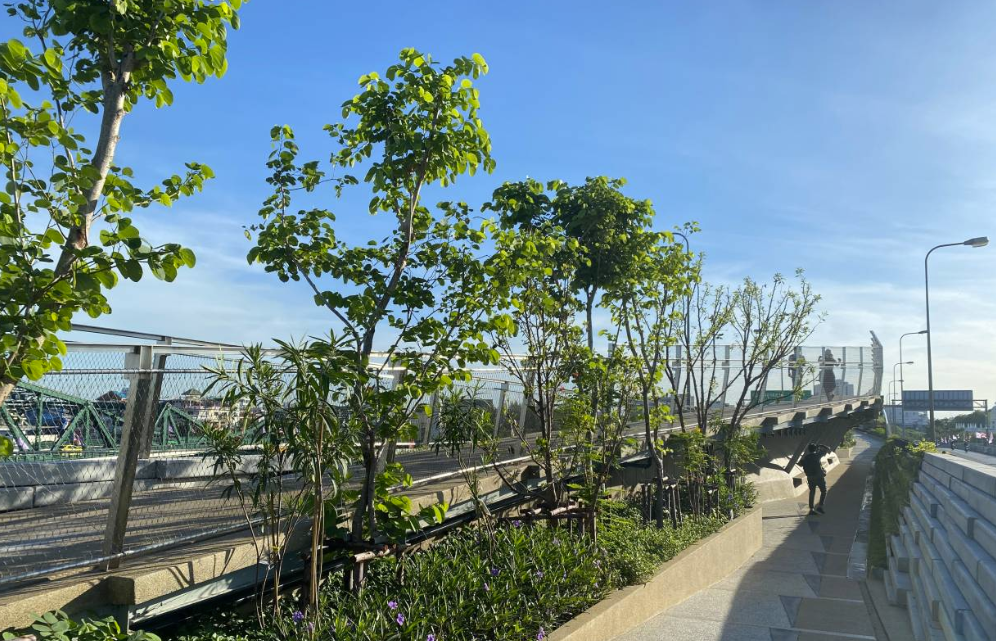This abandoned train track in Bangkok has been transformed into an urban sky garden
Bangkok has converted an abandoned railroad track into a tree-lined walkway.This green space, that will be unveiled later this month, will reduce air pollution and provide shade in the space-sparse city.
A
new park in Thailand’s capital – built on an abandoned train track – can be a model for turning the city’s other unused spaces into much-needed green areas to boost well-being and mitigate climate-change impacts, urban experts said on Tuesday.
The Phra Pok Klao Sky Park in Bangkok, which is scheduled to open later this month, connects neighbourhoods on either side of the Chao Phraya river and was built on an elevated rail line that lay unused for more than three decades.
“It is an example of how to repurpose an abandoned structure and increase green spaces in Bangkok through cost-effective design,” said Niramon Serisakul, director of Urban Design and Development Center, a consultancy that led the project.
“It may not be large, but it has outsized importance as a catalyst for urban regeneration, and can change the way people look at public spaces,” she said.
The lack of green spaces in Bangkok and other crowded cities has come under scrutiny as the coronavirus pandemic forced lockdowns worldwide, triggering a rush to parks for exercise and to improve well-being.
The health benefits are clear: city dwellers tend to live longer in leafy neighbourhoods, according to a study last year by the Barcelona Institute for Global Health.

The elevated park is 280 metres long and 8 metres wide. Photo by Thomas Reuters Foundation/Rina Chandran
A city built on a floodplain
Bangkok, built on the floodplains of the Chao Phraya River, is also forecast by climate experts to be an urban area that will be hardest hit by extreme weather conditions in the coming years.
Flooding is already common during the monsoon season, but nearly 40% of the city could become flooded each year by 2030 due to more intense rainfall, according to World Bank estimates.
“The effects of climate change are being felt more, so we need more green spaces,” Asawin Kwanmuang, governor of the Bangkok Metropolitan Administration, said at a ceremony to plant trees ahead of the park’s opening.
“Our goal is to increase green space in Bangkok from about 6 square metres (65 sq ft) per person to 9 square metres per person. At the same time, we want to reduce the number of cars and make the city more walkable,” he told the Thomson Reuters Foundation.
The park, measuring 280 metres by 8 metres, makes it easier for residents to access nearby schools, markets and places of worship, said Niramon.
The goal is to replicate Paris’s “15-minute city”, where people can reach their destination within 15 minutes of walking, cycling or using mass transit, she said.
Across Asia’s space-starved cities, developers and planners are increasingly turning to so-called “dead land” underneath bridges, flyovers and viaducts.
Bangkok’s new sky park can be a model for swathes of unused land under the city’s expressways, said landscape architect Kotchakorn Voraakhom, who was involved in the project.
Parks and rooftop gardens can reduce air pollution and harmful emissions, and also limit flooding, said Kotchakorn, who has designed a rooftop farm and park that can retain water.
“With the sky park we have shown it is possible to create green spaces from existing structures that can be valuable in fighting climate change,” she said.
The ideas presented in this article aim to inspire adaptation action – they are the views of the author and do not necessarily reflect those of the Global Center on Adaptation.